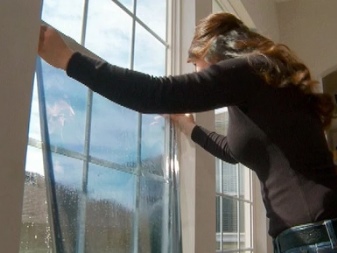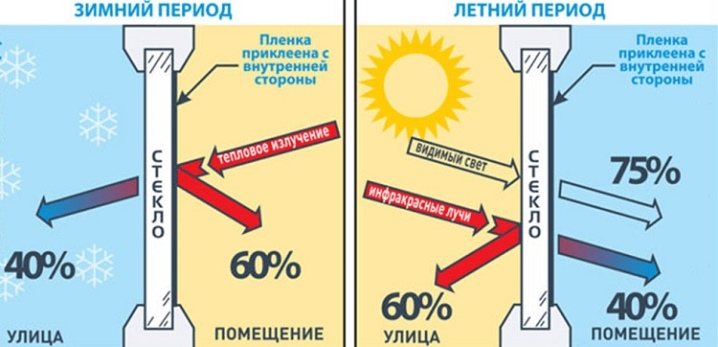Features and application of heat-saving film

Heat-retaining film is not the main one, rather, an additional way to reduce heat loss in rooms and the car interior in winter. Specific heat loss is reduced by about 15–20%. In this article, we will consider the features and application of heat-saving film.


What it is?
Heat Saving Film reflects heat back into the home or building. It cuts off radiation in the thermal (infrared) range, allowing visible light to pass through. A significant part of the heat is not lost in the space outside the enclosed space, but returns to the room or the interior of the car. The technology for manufacturing a heat-reflecting film is based on a combination of a metal layer (or spraying from it), which conducts heat well, and a layer with low thermal conductivity. The first one evenly redistributes the received heat, the second one prevents it from dissipating further, beyond the boundaries of the delimited zone.
The ideal heat-insulating "cake" is the inner wall of the thermos, bordering on the vacuum, and not on the film-porous structure.

Species overview
Architectural thermal film is transparent, it is used on glass windows of buildings, structures and cars. The usual one does not have transparency, it is placed under a stretch ceiling, wall panels, laminate and parquet, and hidden under the trim (upholstery) of the car interior. Both the one and the other delimit the owners and / or workers in the summer from the heat outside, and in the winter - retains most of the heat. In both cases, air conditioning and heating costs are significantly reduced.
Ordinary (ceiling and wall, underground) thermal insulation film is made on the basis of the following materials:
- foamed polyethylene;
- fibrous polypropylene;
- lavsan fiber or fabric.


According to the method of applying the heat reflector, the film is divided into the following types:
- foil layer;
- sputtered composite layer.
Foil in damp rooms is subject to accelerated destruction. Because of this, foamed foam or fiber is not used in baths and saunas, bathrooms, toilets and in the kitchen. The spraying is protected by a thin, microscopic layer of plastic, dust particles of metal (aluminum) do not deteriorate. The heated spraying is slightly fused into the polymer base even at the production stage. This is a technology that is higher than foiling, which is closely monitored in factories.
Thermal film for walls and floors - stenofon - is similar to ordinary penofol. It has a porous or bubble structure. It is placed under the decorative coating, which is why it will not be possible to avoid heating the wall panel from the inside of the room, but this is not as important as the real escape of excess heat through the wall to the outside.


Self-adhesive
This subspecies is similar to the film used for the screen of a smartphone or tablet. For clear gluing, without air bubbles under specks and lint, a general cleaning is carried out in the room and all "dusty" things and objects are taken out. To protect the adhesive side from dust and moisture during transportation, a protective layer has been applied to it by the manufacturer. Self-adhesive production is a technology that requires ultra-clean factory conditions; the same cleanliness is ensured at the customer's site.
It is difficult to stick this film yourself - one skew, and it is difficult to remove wrinkles, since removing and re-sticking the same piece of film will dramatically affect the transparency and attractiveness of the window, glass. This film is glued, starting from any of the corners, gradually pulling back the protective layer. Car tinting requires no less care than gluing a film on the windows of a house or building.
The film "Third Glass", used for single-chamber insulating glass units, is supplied with double-sided tape of the same transparency.


Shrink
Shrink option - a film for the window frame. It is fixed with double-sided tape. An air gap forms under it, preventing heat from quickly leaving the room. The initially glued heat-shielding film resembles crumpled polyethylene. To straighten it, direct hot air from a hair dryer at it - now the stretched fabric looks neat.


Under soapy water
This coating is similar to tinted glass and is durable. The second advantage is ease of application. Any soap without aroma additives is suitable as an attracting layer.


Criterias of choice
For window panes, only transparent film is suitable. It will protect against excess ultraviolet radiation and retain up to 30% of infrared radiation, but visible light penetrates the room almost completely. There are darkened and even specular options that block out some of the visible light - similar to autotone. During the day, the owners will be protected from prying eyes from the outside. For such secrecy, the landlord pays for the inability to grow anything - the plants need sunlight. Almost any film that does not leave wrinkles after installation is suitable for the frame. Decorative - will change the color of the frame from white to any of those that were available at the time of purchase in the assortment of the building market. Do not skimp on quality: cheap films quickly fade and crack from ultraviolet radiation and excess heat.
Do not use films for glass that have a manufacturing defect - distinct inclusions of metal, visible to the naked eye... A film that has been in use for several years can significantly lose its adhesive power. It must hold the shards of accidentally broken glass - this reduces the injury rate of people and makes it difficult for thieves to access the locked room. The same applies to car tinting - in case of an accident, the driver will not be covered with broken glass. For batteries, especially those located in the niche of the outer wall of the building, not so much a thin film is used, as the usual foil foam. It can withstand heating up to +120 degrees - the battery rarely even gives out +90. The film will last at least several years of constant heat load.


Installation rules
Heat-reflecting foil is not used near a sauna stove or heated stove. Cheap film supports combustion - it is fire hazardous... You cannot use the film without removing the layer protecting the adhesive side, stick this layer with glue or tape, trying to save on the film itself. The removable layer protects the adhesive side, but itself becomes cloudy from many "line" scratches, visibility through such glass is reduced to an almost matte state.
Before gluing, the surface of the glass or frame is thoroughly cleaned and washed. It is impossible to stick the film of all types that do not use soap solution on a damp, not thoroughly dried surface - bubbles form, which are extremely difficult to remove without losing the quality of the new coating.
After removing the protective layer, the film must immediately be glued: dust particles and debris will irreversibly spoil it if it lies in a protected place for several hours. Some adhesives will simply dry out during this time, and the film will become unsuitable for high-quality installation.


In the next video, you are waiting for the installation of a heat-saving film on the window.













The comment was sent successfully.